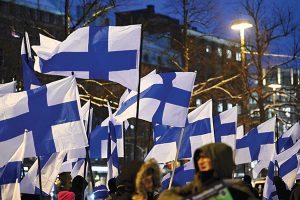Bloomberg
For much of the last 30 years Finland’s armed forces have looked a little old fashioned, still configured to fight a major land campaign in Europe as though the Cold War never ended. No more.
As Finland readies to join the North Atlantic Treaty Organization (Nato) against the backdrop of Europe’s bloodiest war since 1945, in Ukraine, the Nordic nation’s military is back in vogue. Its commanders are also well aware of what they bring to the table in a potential fight.
“We have significant defensive ability to wage the kind of war that’s now taking place in Ukraine,†Finland’s top commander General Timo Kivinen said. “On a per capita basis, we have probably the most fire power in Europe.â€
Finnish officials admit to frustration that the country has yet to join Nato six months after the alliance issued its invitation. That has left both Finland and fellow-invitee Sweden in a so-called “gray†zone between abandoning military non-alignment and gaining Nato’s Article 5 collective defense protections.
“We already fulfill the military criteria for membership, and looking at our defense expenditure, we comply with the 2% of GDP criterion,†Kivinen said.
Despite a population of just 5.5 million, Finland has more artillery than France and Germany combined and can call on as many as 280,000 troops in time of war. Though most of those are trained reserves, the figure is larger than that of the UK.
Finland’s fleet of F/A-18 Hornets armed with advanced US missiles will soon be replaced by 64 Lockheed Martin F-35A aircraft joint strike fighters. At sea, there are elaborate coastal defenses and a shallow water navy tailored for the rocky coasts of the Baltic, plus a capability for fighting in the Arctic and, in Lapland, Europe’s biggest training area for air combat across the three Nordic countries.
The memory of past invasions from the east has given Finland a powerful incentive to retain the means to defend its 1,343 km (835 mile) border with Russia even after the collapse of the Soviet Union in 1991. Other European nations dismantled their territorial defenses in the belief that a state-on-state war on the continent had become inconceivable.
“We didn’t do that,†Kivinen said. All but two of Nato’s 30 member countries have ratified accession for the Nordic nations. Hungary recently said it will not put ratification to parliament until next year.
Nato diplomats and officials are convinced Hungary will ultimately come on board and note the ratification process is still likely to be one of the fastest in the organisation’s history. And while Finland isn’t yet fully covered by Article 5, the security risk is mitigated by commitments from the UK, US and others to defend the Nordic nations if they are attacked before becoming full members.
The delay is also causing anxiety in the three Baltic states of Estonia, Latvia and Lithuania. The addition of Finland and Sweden to Nato is seen as a significant improvement to security for the hard-to-defend ex-Soviet territories, solidifying alliance control over the Baltic Sea at their backs.
But doubling Nato’s land border with Russia brings new liabilities — officials in Moscow have said they will respond. It is hard to see what they could do though because the Finland section is already defended and any Russian response would involve a dispersal of resources from other theatres.
According to Kivinen the war in Ukraine has confirmed the growing importance of air defenses in modern warfare. Finland has invested far beyond the 11 unmanned aerial vehicles listed in the Military Balance, he said.
 The Gulf Time Newspaper One of the finest business newspapers in the UAE brought to you by our professional writers and editors.
The Gulf Time Newspaper One of the finest business newspapers in the UAE brought to you by our professional writers and editors.
